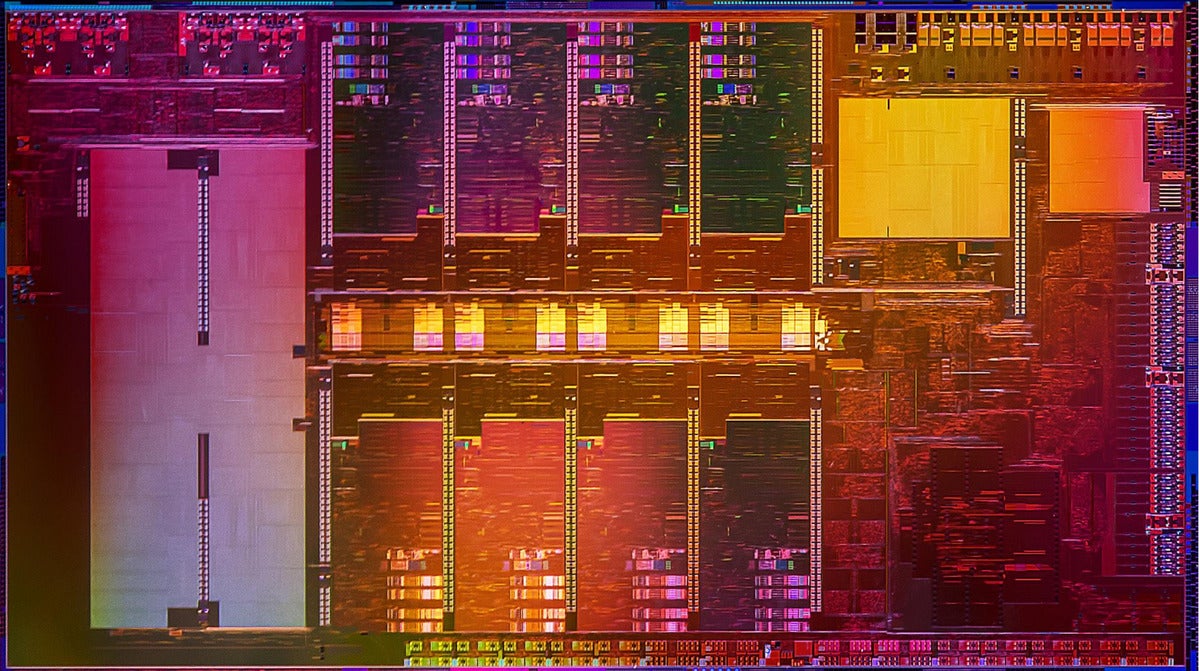Intel’s latest processors for gaming PCs trim clock speeds a bit, but offer what Intel says are substantial performance improvements and lower power.
Intel
Today’s Best Tech Deals
Picked by PCWorld’s Editors
Top Deals On Great Products
Picked by Techconnect’s Editors
Just a few short months after Intel launched the 11th-gen Core H35-series microprocessors for mobile gaming, Intel is at it again: On Tuesday, Intel officially launched the 11th-gen Core “Tiger Lake” H-series processors for mainstream and gaming laptops.
The product line includes five new processors, including the premium, unlocked Core i9-11980HK, the Core i7-11800H, and a pair of Core i5 processors. Quad-core processors have disappeared from the lineup. Instead, the new chips include hyperthreaded six-core and eight-core processors, offering double the cores of the 11th-gen Tiger Lake cores Intel launched in September.
Versus last year’s 10th-gen Core mobile gaming chips, base core clock frequencies are slightly up across the board. The maximum single-core boost clock has dipped, though—possibly a black mark for gamers. However, Intel is once again publishing its all-core turbo speeds, and they’re substantial. Supported memory speeds have climbed from DDR4-2933 to DDR4-3200. Power has dropped, too: Virtually all of the new processors are rated at 35W, rather than 45W. Overall, Intel claims that the Tiger Lake-H platform offers three times the platform bandwidth of its predecessor, with a mix of 20 PCI Express 4.0 and 24 PCI Express 3.0 lanes. Oh, and integrated graphics have returned, too.
Intel would also like to tacitly remind you that demand for rival AMD’s Ryzen processors is outstripping supply. Intel executives say they’ll ship more than a million of the 11th-gen Core H processors to customers by launch, as part of more than 80 new designs. They’ll also continue selling 10th-gen H-series chips. Naturally, Intel believes its new 11th-gen Core H parts outperform AMD’s Ryzen 9 5000 processors in gaming, by about 11 to 22 percent.
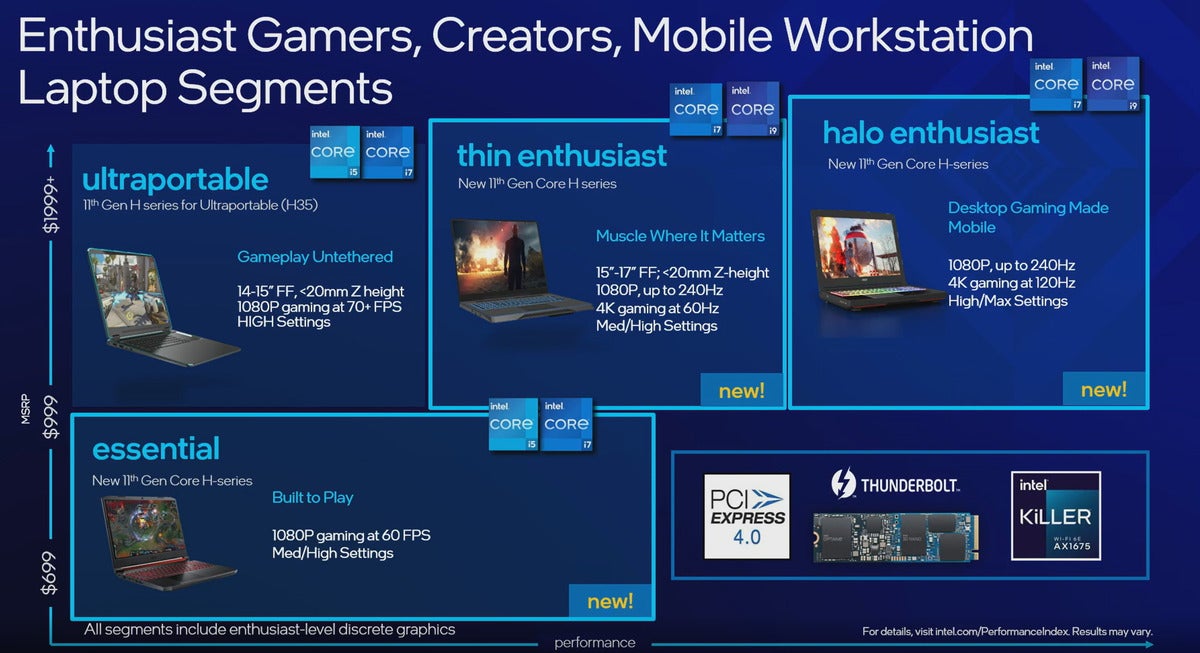 Intel
IntelHere’s how Intel sees the gaming notebook market breaking down.
Inside a Tiger Lake-H gaming notebook
it’s been a busy year or so for Intel. Let’s recap: Last April, Intel launched the 10th-gen Intel “Comet Lake”-H processors. The Core i7-10875H finally reached 8 cores and 16 threads, while the premium Core i9-10980HK topped out at 5.3GHz. Our tests of the Core i7-10875H proved it was indeed the fastest Core i7 processor to date, though our tests of AMD’s Ryzen 4000 Mobile processor showed Ryzen keeping pace. In January, Intel added new 10th-gen Core i5 and Core i7 Comet Lake-H chips to the lineup.
January’s launch, not today’s, was Intel’s first 11th-gen mobile Core debut, when it pioneered a new ultraportable gaming segment with the Core H35 series. It was then that PCI Express 4.0, Wi-Fi 6E and Intel’s Killer networking technology arrived in Intel’s 11th-gen mobile processors. Now they’ve migrated to the mainstream gaming line as well.
What does an 11th-gen Core mainstream gaming notebook include? According to Kim Algstam, interim general manager of Intel’s Innovation and Enthusiast team and director of Intel’s enthusiast laptop innovation team, Intel’s aiming its Core i5 H-series chips at “essential” gaming notebooks for as little as $699 to $999, running at 1080p resolutions at Medium to High settings. More expensive models will be priced between $999 to $1,999: 15- to 17-inch notebooks running at either 1080p/240Hz or 4K/60 resolutions, and more powerful “halo enthusiast” notebooks running at 4K/120 resolutions at maxed-out settings. (Up to 1080p/360 and 4K/120 displays are supported, too.) All will include discrete, enthusiast-class GPUs from either Nvidia or AMD.
Interestingly, Algstam said Intel is helping support a new display size of 16 inches, which would split the difference between the more traditional 15-inch and 17-inch gaming laptops. Intel also sees 1440p resolutions as the “new gaming standard.”
Here are Intel’s 11th-gen Core mobile processors
The architecture of the chips themselves doesn’t hide any surprises. These are 10nm chips, designed around the Willow Cove CPU cores Intel talked up last year. However, Intel executives said that though the GPU cores are designed around the Xe architecture, they’re being branded as Intel UHD Graphics for some reason. That’s still a change from the 10th-gen “Comet Lake-H” chips, when Intel said gamers simply preferred discrete graphics and didn’t need an integrated GPU.
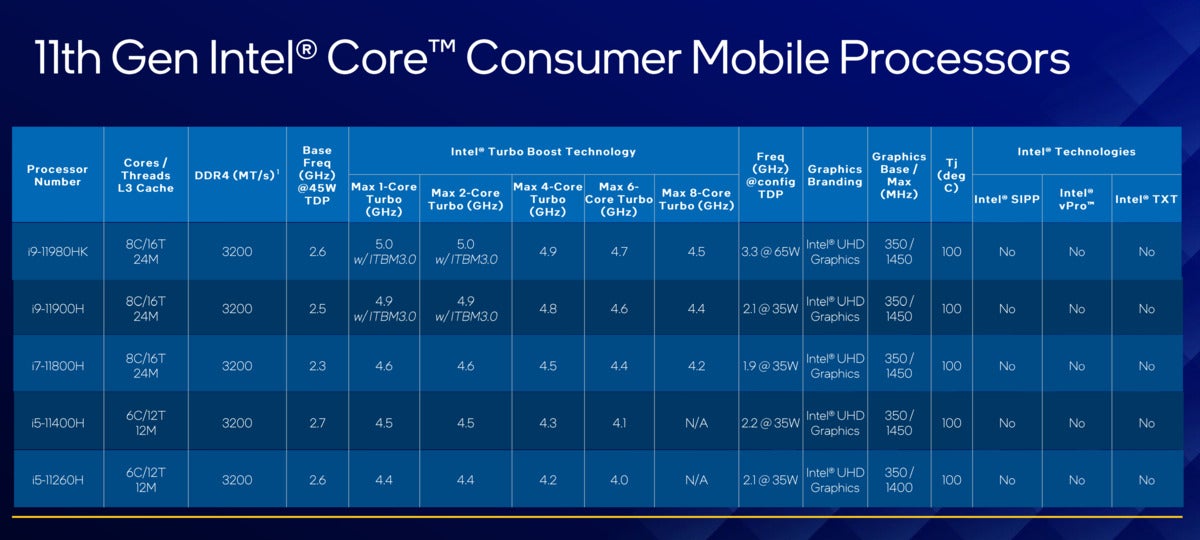 Intel
IntelIntel is offering five new 11th-gen Core H-series chips for consumers.
Intel’s chart, above, includes several different scenarios. The base clock speed of the Core i9-11980HK, for example, is just 2.6GHz. Intel is also showing that chips like the Core i9-11900H, while designed for 35W, will typically run inside of a 45W notebook and at a slightly faster speed when doing so.
At 45 watts, these 35W chips will run a bit faster. When boosted using the Intel Turbo Boost Max 3.0 technology, either one or two “favored” cores can reach 5.0GHz for a short time. Scenarios like our Cinebench benchmark will push all of the cores on that chip to 4.5GHz, consequently pushing up the power consumption to as high as 135 watts, according to Ryan Shrout, Intel’s performance guru.
The ‘K’ suffix designates an unlocked part that can be overclocked. Intel executives also alluded to “partially overclockable” chips that can use Intel’s Speed Optimizer, but didn’t clarify which ones they were.
Intel also launched several similar processors for the commercial segment, featuring vPro technology.
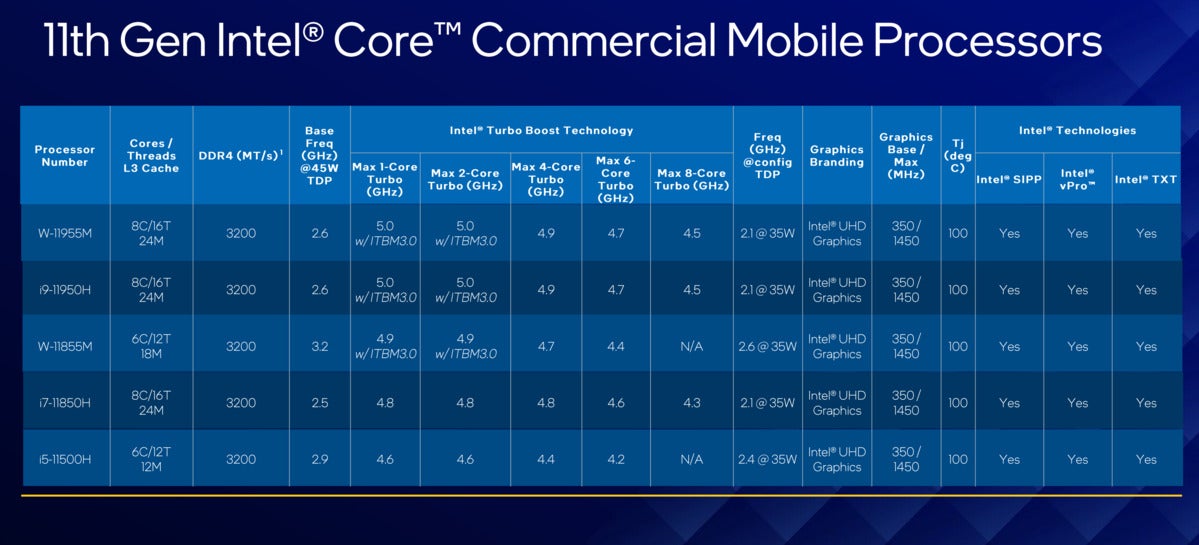 Intel
IntelIntel’s performance benchmarks for its 11th-gen Core-H mobile processors
How fast is the new 11th-gen Tiger Lake H processor? Intel claims there’s a 19-percent generation-to-generation performance increase (as measured by the SPEC_int_rate_base2017 benchmark) between the Core i9-11980HK processor and the earlier Core i9-10980HKchip. In gaming, Intel says that you’ll see frame rate improvements between 5 and 21 percent in some popular titles.
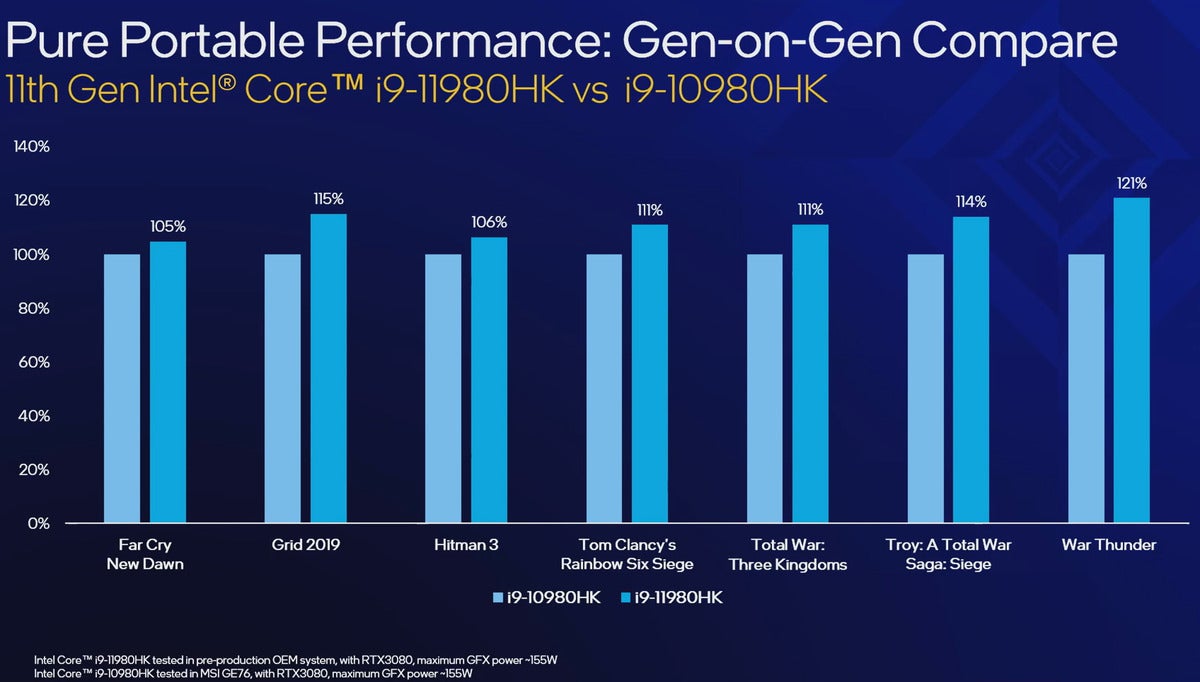 Intel
IntelHere’s what Intel claims are the generational improvements over the older 10th-gen Core-H chips. Both systems are using an Nvidia GeForce RTX3080 GPU.
Intel ran similar benchmarks comparing the top-of-the-line Core i9-11980HK versus the Ryzen 9 5900HX, AMD’s most powerful processor. Again, Intel is using gaming as the point of comparison, with an RTX 3080 supplying the graphics horsepower. In the games Intel selected, the 11980HK outperforms the 5900X by up to 26 percent.
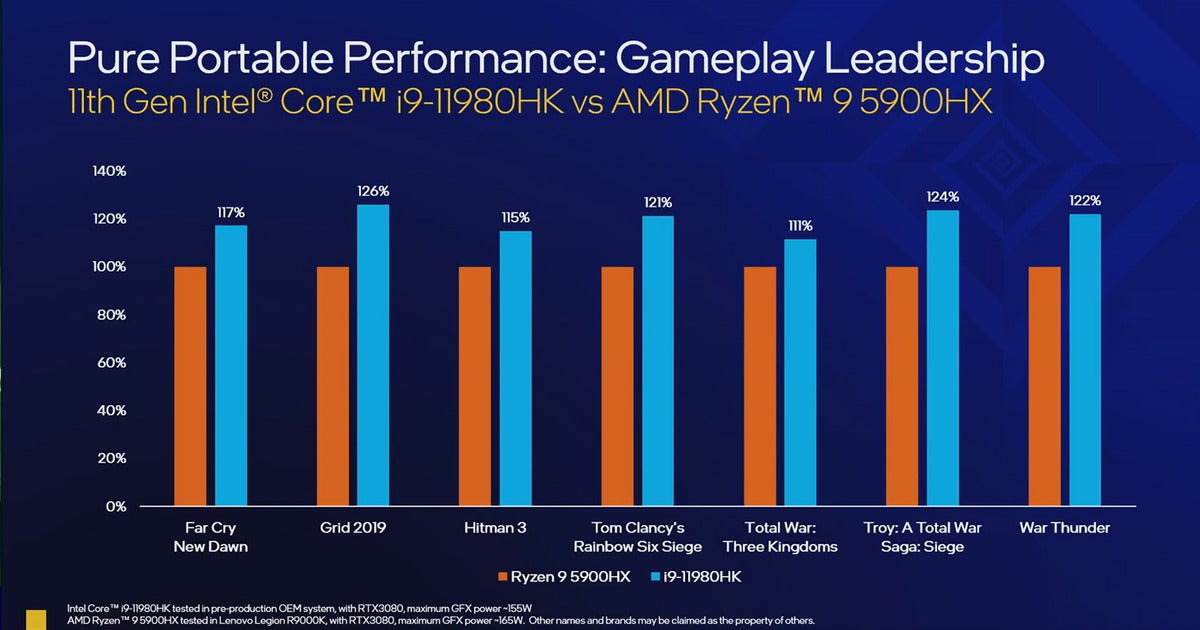 Intel
IntelIntel is claiming that its top-of-the-line Core i9-11980HX handily outperforms AMD’s Ryzen.
Intel used a similar subset of games to draw a comparison between the much more affordable Core i5-11400H and the Ryzen 9 5900HS. Here, the two processors are more closely matched, with Intel admitting that its rival outperforms it in certain situations. Intel, however, claims that its demo notebook is just 16.5mm thick and consumes 65W, while the Ryzen system measures as much as 20mm thick and consumes up to 80 watts.
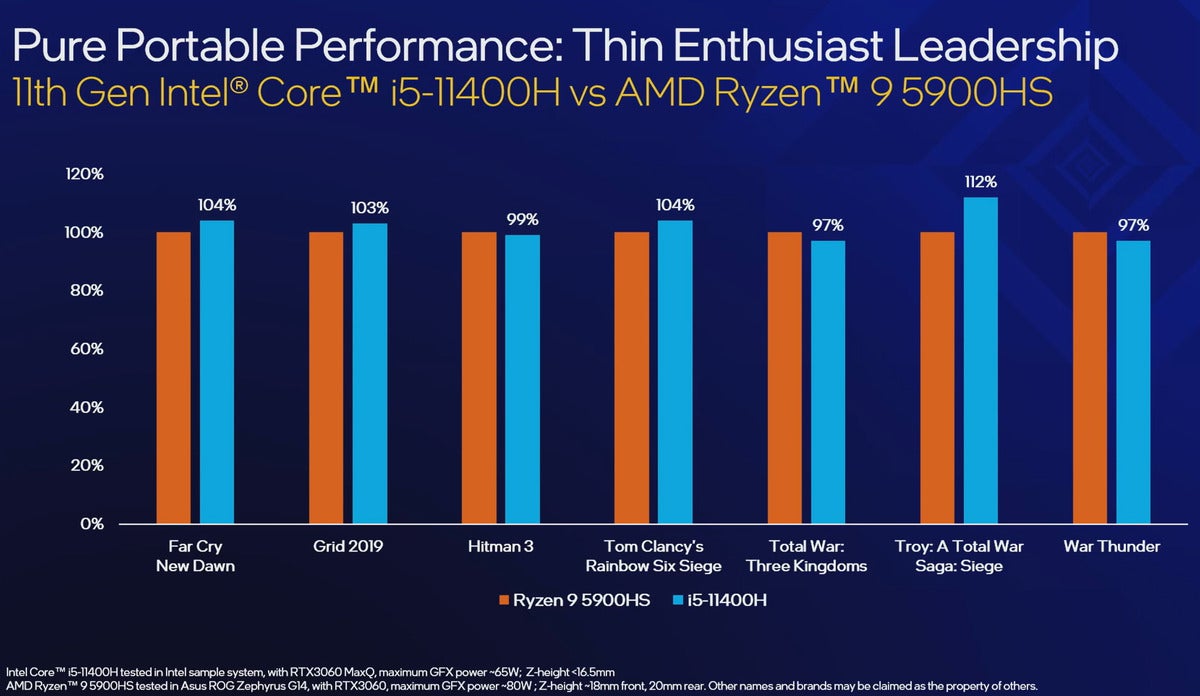 Intel
IntelMany gamers will buy a Core i5 system simply because it offers a lower price without trading off much in the way of performance. Here, Intel’s Core i5-11400H is compared to the Ryzen 9 5900HS. Remember, these are Intel’s benchmarks.
In content creation, Intel is claiming a 22-percent generation-over-generation improvement in Photoshop, and 20 percent in video creation. Intel believes it holds 24-percent and 18-percent advantages in those two, respectively, over Ryzen 9 5900X. Intel’s Shrout said he believes those improvements stem from the overall computational gains from one generation to the other, plus some of the AI-specific enhancements like DLBoost that Intel has built in.
How does Intel’s 11th-gen Core match up to Apple’s M1? “We don’t have any of that information here to share today,” Shrout said.
The improvements Tiger Lake-H adds to mobile PCs
As AMD’s Ryzen has risen to challenge Intel’s Core chips directly, Intel has shifted gears to emphasize some of the other advantages an Intel PC brings beyond raw performance. These “platform” improvements touch on other aspects of the PC that may be unique to Intel, generally emphasizing additional bandwidth such as the new 40Gbps Thunderbolt 4 specification for connecting external storage. For better or worse, Thunderbolt is still largely exclusive to Intel PCs, with exceptions like this Asus desktop motherboard. Intel isn’t even mentioning USB4, though the USB4 specification and Thunderbolt 4 go hand in hand.
For Intel’s new Tiger Lake-H laptops, a few capabilities stand out. For one, the platform now supports DDR4 3200, which represents a small 9-percent boost from the DDR4 2933 memory speeds of the 10th-gen parts.
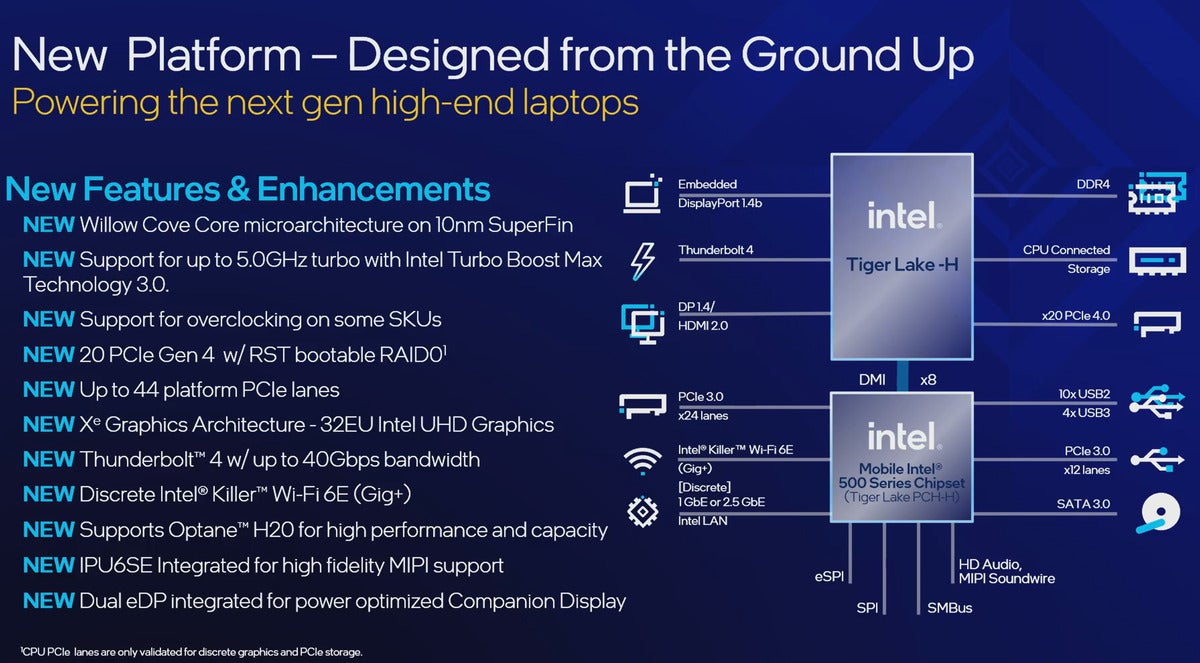 Intel
IntelA summary of the improvements that Intel has added to its mobile 11th-gen Core platform, code-named Tiger Lake H.
These days, the PCI Express bus is primarily used just for discrete graphics and storage. Intel’s Tiger Lake-H laptops contain 20 lanes of PCI Express 4.0 I/O directly attached to the CPU, allowing for an x16 discrete GPU plus an x4 SSD for internal PC storage.
The DMI link between the host CPU and the accompanying 500-series PCH chipset has also been widened, to an x8 interface. All this means that the available bandwidth between the I/O chip and the CPU has doubled, allowing the PCH an additional 24 lanes of PCI Express 3.0 storage to an external GPU or additional SSDs. These are PCI Express 3.0 lanes, granted, with half the bandwidth of the PCIe 4.0 lanes directly attached to the CPU.
Still, you may see notebooks that combine SSDs attached to both PCIe 4 and PCI 3, to create RAID 0 arrays that could increase a laptop’s storage performance even further. And, of course, Intel has also included support for its H20 Optane drives.
Because Intel envisions its Tiger Lake-H notebooks being used with external graphics, the platform’s integrated graphics come as a little bit of a mystery. These chips include integrated graphics based on the Xe architecture, and with 32EUs to boot—but they’re being marketed as Intel UHD Graphics. They do include an unexpected bonus: They’ve been designed to work with two external DisplayPort connections, specifically for the secondary “companion displays” that have begun cropping up in dual-screen laptops like the Asus ZenBook Pro Duo. It’s reasonable to expect that they’ll be able to step in and power day-to-day web and Office work versus using the external GPU, helping preserve your laptop’s battery life. They also support AV1 decoding in hardware.
Finally, these new 11th-gen Tiger Lake platforms include Intel’s Killer networking technology, which Intel acquired a year ago for gaming PCs. The new notebooks will include support for Wi-Fi 6E, which adds a new dedicated 6GHz Wi-Fi channel for (hopefully) less wireless congestion.
With a global semiconductor shortage, a cryptocurrency craze, and opportunistic resellers and bots snapping up the available supply of discrete desktop GPUs, gaming notebooks are not just a nice luxury—in certain cases, they may be the only way for gamers to be able to play the latest games. Intel’s new 11th-gen Core H-series mobile parts may take on an outsized importance as the weeks progress.
Note: When you purchase something after clicking links in our articles, we may earn a small commission. Read our affiliate link policy for more details.
As PCWorld’s senior editor, Mark focuses on Microsoft news and chip technology, among other beats.


